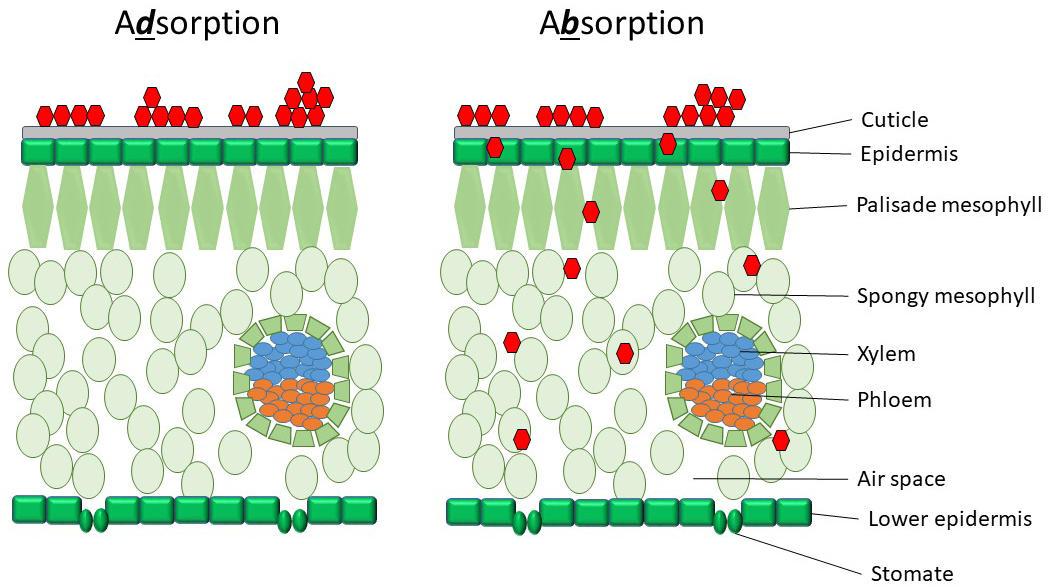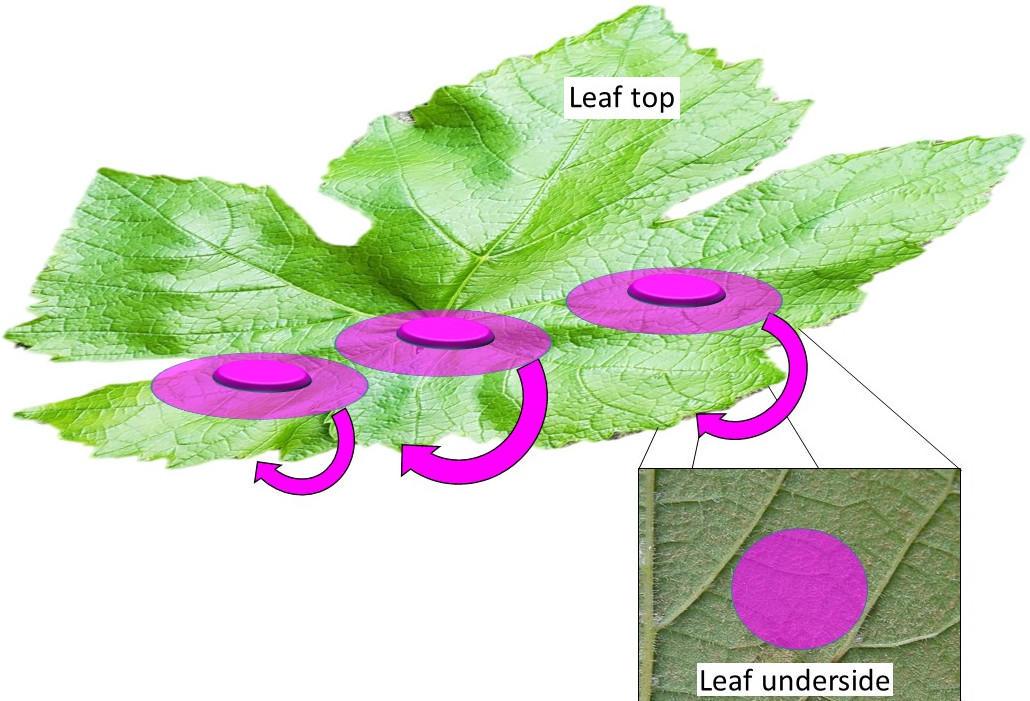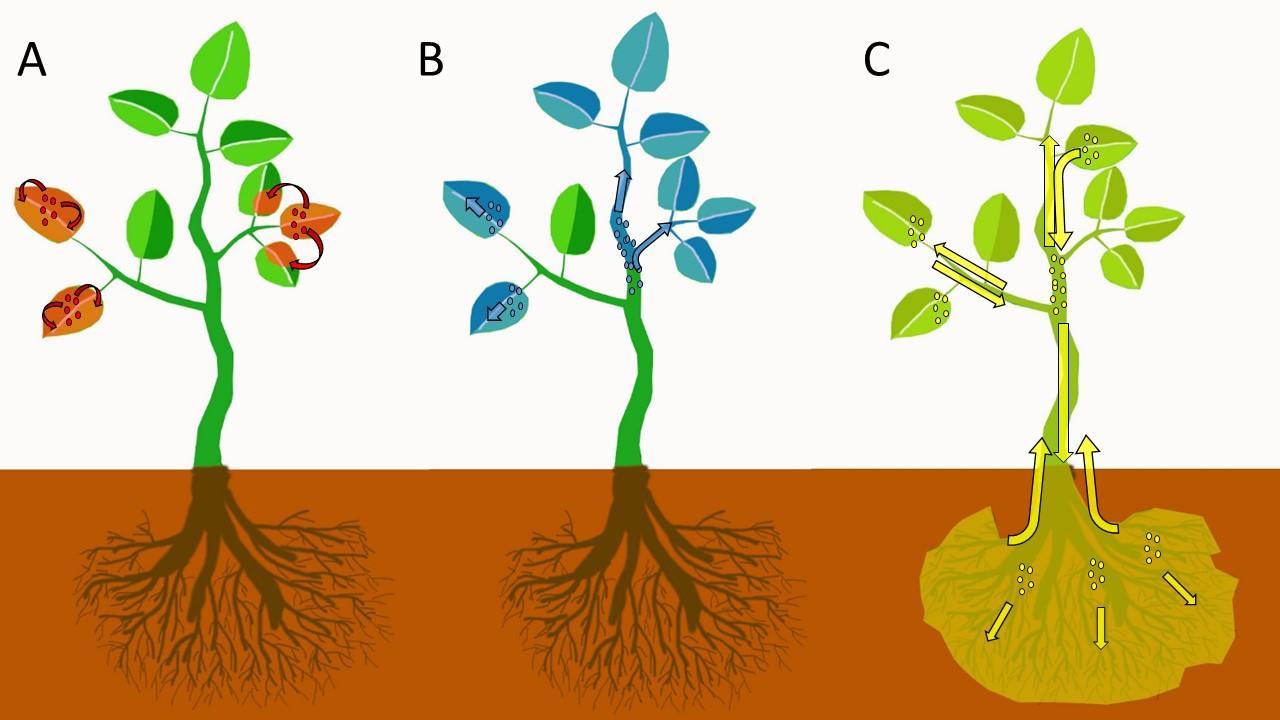Introduction
Agrochemical manufacturers focus on producing pesticide products that are effective on pests and pathogens while presenting lower risks for the applicator and environment. Synthetic chemicals account for the majority of pesticides applied. Their predominance is partly due to their high efficacy. One important aspect of some synthetic pesticides that enhances efficacy is the ability of the active ingredient to absorb into plant tissues and translocate to another part of the plant.
Pesticide applications rarely result in even coverage across all susceptible tissues, and pesticide redistribution aids in their efficacy and reliability. Yet, there currently are no comprehensive resources detailing the redistribution properties of pesticides. This guide provides a general overview of commonly used products that redistribute. It focuses on pesticide redistribution and how this concept can help inform pesticide choice.
What is pesticide redistribution?
Pesticide redistribution is the movement of a pesticide from its initial point of deposition to a different location on or in the plant, where it retains activity against the target pest or pathogen.
Translocation is is another term used to describe the process of a pesticide moving from one point to another in a plant. But translocation refers more explicitly to materials moving within the plant xylem or phloem vessels.
Chemical manufacturers do not always provide redistribution characteristics of their products on promotional information and labels. As a result, some products that are not advertised as being able to redistribute do redistribute, and in some cases to a greater extent than products that advertise for this characteristic.
Adsorption versus absorption
Most foliar pesticides are applied with a water carrier that dries, leaving the active ingredients on the surface of the plant tissue. Adsorption is the adherence of compounds to the plant tissue by intermolecular forces (Figure 1). This molecular force works like a magnet to hold the pesticide compound to the plant tissue. Fungicides containing sulfur, copper or bicarbonate are examples of products that rely on adsorption to retain their residues on plant tissue. These fungicides are termed “contact” or “protectant” products. They work by forming a barrier the pest or pathogen must penetrate to reach plant tissue. One challenge with these types of products is that rainfall or irrigation water can dislodge them, so additional applications may be needed to maintain protection. They also need to be applied as plants grow to cover new growth.
Absorption is the process of a pesticide passing through the cuticle and epidermis — the two outermost layers of the plant tissue — and into the interior of the plant (Figure 1). Once inside the plant tissues, a pesticide will be less susceptible to being washed off by rain or irrigation.
Many synthetic pesticides attach to the plant surface through adsorption and can also be absorbed into plant tissues.
Pesticides that can undergo absorption by plants typically have longer residual efficacy due to decreased wash-off and increased resistance to UV degradation. Adjuvants added to spray mixtures can increase adherence and absorption of synthetic pesticides to plant tissues.
After absorption, some pesticides can be transported either locally, or locally and over longer distances via the xylem or phloem.
Types of pesticide redistribution
Water-splash redistribution
Rain or irrigation water can wash contact pesticides from the plant surface. This is not always a problem, as rain or irrigation events can redistribute residues around on plant surfaces, sometimes leading to areas larger than the original pesticide deposit of protection.
Three factors affect how a pesticide will be redistributed after a rain event:
- The pesticide formulation.
- The amount or characteristics of the precipitation or irrigation event.
- The toxicity of the pesticide on the target pest.
Pesticide formulations such as dusts and wettable powders are more easily dislodged by rain than oil-based formulations such as emulsifiable concentrates. When emulsifiable concentrate products dry after an application, the oily residues stick to plant cuticles and waxy outer layers. Wettable powders and dusts contain the active ingredient integrated with clay, talc or other similar materials that can be physically washed around or off plant surfaces with water.
The amount of accumulated rain or irrigation is more important than the duration of the rain event on the water's spreading effect. Depending on the product, half an inch of rain or less will tend to redistribute the residues around the canopy; more rain will wash residues off plant tissues. However, efficacy following a precipitation event depends greatly on how toxic the pesticide is on the target pest or pathogen. If the product is highly toxic, there is a higher chance there will be enough residues to be effective than when using a lower-toxicity pesticide. Thus, applying a pesticide before a rain event can in some cases result in enough residues to prevent infection by a plant pathogen, even if the rain washes off some of the product. Considering all that, base the decision to reapply after a rain event on the biology of the pest or pathogen, the risk to the crop, the product used and weather.
Translaminar
Translaminar redistribution (Figure 2) is when a compound moves from the sprayed side of the leaf into and over to the unsprayed side, resulting in protection to both sides of the leaf. For translaminar redistribution to occur, the pesticide must first be absorbed into the plant. Afterward, the pesticide can move from its deposition location to the other side of the leaf.
The local redistribution can also result in a “halo” of protection around a pesticide deposit, where the pesticide has diffused into the tissues surrounding the deposit. For some products, this halo can expand to about twice the size of the deposit. For others, it can measure about 10 times the size of the deposit.
Vapor
Vapor redistribution (Figure 3A) occurs when deposits of pesticides on the surfaces of plant tissues volatilize. They move either laterally along a plant surface, or through free air, where they are subsequently re-deposited to the plant surface.
Vapor redistribution refers to the beneficial form of pesticide vaporization where the vapor helps distribute the pesticide across leaf tissues.
There is a wide variety of vapor activity among pesticides. Some products redistribute easily by vapors, while others depend on specific temperatures or environmental conditions. Among products that can vaporize, insecticides and fungicides generally are only volatile enough to effectively move laterally across plant surfaces. They are not volatile enough to move from plant to plant. While inherent volatility varies widely among herbicides, no reports of vapor redistribution indicate improved efficacy on target weeds.
Vapor drift, a different type of pesticide movement, occurs when the pesticide is volatilized and the vapor travels through the air, causing unwanted damage to nontarget plants. Some herbicides have been shown to move more than 100 feet as vapor drift, damaging nontarget plants. This is why pesticide manufacturers generally try to avoid volatility among herbicide products.
Xylem and phloem systemic
Xylem systemic (Figure 3B) refers to the absorption of a pesticide and its systemic movement through the xylem vessels of a plant. Xylem vessels move water and minerals upward and outward in plants (also known as acropetal movement). There is little to no movement of water and nutrients downwards or backwards along branches or leaves in xylem vessels.
Xylem redistribution can help protect actively growing tissues from pest damage when the pesticide redistributes to those tissues. Most systemic fungicides and insecticides redistribute via the xylem.
Phloem systemic (Figure 3C), also called true systemic, is the bi-directional movement of pesticides upwards to leaves and other structures and downwards to roots (also known as basipetal movement) within a plant after absorption. Phloem vessels transport sugars and other nutrients throughout the plant but primarily towards carbohydrate sinks such as fruit and roots.
When pesticides are referred to as “locally systemic,” it often implies that they exhibit translaminar or vapor redistribution properties, not xylem or phloem systemic properties.
Pesticide redistribution (excluding water splash redistribution) often occurs by more than one mechanism. For example, a translaminar fungicide can also redistribute via the xylem. We can think of pesticide redistribution as a continuum between translaminar, vapor, xylem systemic and phloem systemic. However, the pesticide may not be able to redistribute enough to act against the target pathogen or pest by each pathway.
Soil-applied systemic pesticides
Some systemic pesticides can be applied to the soil through drenches, drips or injections. Once in the rooting zone, plant roots can absorb the pesticides similar to how they absorb nutrients. Following root absorption, pesticides can be translocated via the xylem or phloem in a systemic manner.
Soil-applied insecticides and fungicides can have residual efficacy in some cases of up to 12 weeks, while herbicides can lead to residual activity of over a year. However, soil-applied pesticides can be slow to reach an effective concentration within the plant. For example, the insecticide imidacloprid took six to eight days to reach the threshold concentration for control of glassy-winged sharpshooter (Homalodisca coagulata) in 20-year-old grapevines.
Soil-applied systemic pesticides have drawbacks. Their potentially longer persistence may cause elevated residue levels on or in harvested products. Systemic pesticides can also harm pollinators if they are present in floral structures. When applied to soil, some systemic insecticides, such as acephate, do not translocate to or accumulate in flower parts. However, others, such as imidacloprid, can translocate to floral structures. Strictly follow the label before applying systemic pesticides around bloom time to avoid injury to pollinators.
General considerations
In certain cases, choosing a product that can redistribute can improve management of a pest (Table 1). There are three main factors to consider when choosing a pesticide product to help improve the efficacy of an application:
- The crop developmental stage, or the phenology.
- The pest or pathogen to be controlled (including pest or disease pressure).
- The weather.
| Attribute | Systemic | Contact |
|---|---|---|
| Absorbs into plants | Yes | No |
| Rainfast | Yes | No |
| Redistributes to improve pesticide coverage | Yes | Moderate |
| Some can be applied to soil for plant uptake | Yes | No |
Many crops have plant tissues that are difficult to penetrate or cover with pesticides. For example, grape clusters have complex shapes that are difficult to effectively cover with pesticides. Yet, they are the most important plant part to protect from diseases and pests.
For orchard trees or field crops, a dense canopy can reduce spray penetration, resulting in incomplete coverage. In these situations, applying a pesticide that can move or redistribute can result in better control than a contact pesticide. This is because the product can redistribute throughout plant tissues and provide more even protection.
Another instance when redistributing pesticides may be advantageous is when plants are rapidly developing new tissue. When xylem and phloem-systemic materials are applied to actively growing plants, the active ingredient is translocated to unprotected tissues as plants grow. This can result in better protection and longer spray intervals when compared with contact materials that need to be applied as new tissue emerges.
Pests or pathogens that move frequently or reside in difficult-to-penetrate plant tissues are often more effectively controlled with redistributing pesticides. Aphids, psyllids, whiteflies and other piercing-sucking insects, for example, can effectively hide, move or protect themselves from direct spray applications. Xylem and phloem-systemic insecticides can reach any insect that actively feeds on the plant vasculature. Piercing-sucking insects ingest the insecticide while feeding on the plant, no matter where they are. This makes systemic insecticides particularly useful when pest pressure is high.
With fungicides, sprays will rarely cover all areas on a plant, so a redistributing fungicide can more effectively protect all susceptible tissues better than a contact fungicide.
When disease pressure is high, applying the most effective fungicide available can result in the best control. In some cases, this could be a redistributing fungicide. However, most fungicides (including synthetics) are only effective when applied preventively. Cleaning up severe infections usually involves products other than redistributing fungicides.
Many weeds have below-ground structures (such as a taproot or rhizomes) that allow them to regenerate if above-ground structures are killed. If a nonsystemic herbicide is used, the weed would regrow from below-ground structures some time after an application. With a phloem systemic material, the herbicide would be redistributed throughout the weed when applied to the aboveground foliage, killing both the above- and below-ground structures.
Weather factors can play a big role in the effectiveness of pesticides during and after applications. Redistributing synthetic pesticides are often advantageous when rain is expected within 24 hours after an application. Redistributing pesticides can be “rainfast,” meaning that they absorb into plant tissue and resist wash-off by rain or irrigation. When applying pesticides during rainy periods or around irrigation events, carefully read the pesticide label. The label may suggest an interval after which the product is rainfast, or the use of an adjuvant if rain is expected. Other labels have vague guidance or do not indicate their susceptibility to wash-off. If the information on the label is vague or non-existent, don’t apply the pesticide if you expect rain in the next 24 hours.
Spray adjuvants can assist both synthetic and contact pesticides if rain is forecasted. For synthetic pesticides, spray adjuvants such as surfactants or spreaders help the active ingredient penetrate the leaf tissue more rapidly than if the pesticide product was applied alone. Sticker adjuvants are designed to improve the retention of contact materials through rain or irrigation events. However, sticker adjuvants may bind up some pesticides and decrease their penetration into plant tissue. Be sure to check the pesticide label for specific adjuvant uses for the pesticide being applied.
Heat is another weather event that can cause issues with some pesticide materials. Sulfur is a commonly used contact fungicide that can cause phytotoxicity if the temperature and relative humidity are high (90°F (32°C) + and 70%+, respectively) during or shortly after ( less than two hours) an application. In addition, younger tissues tend to be more susceptible to sulfur damage. Be cautious when applying pesticides in hot weather. Adjuvants such as oils or organosilicone surfactants can cause phytotoxicity, and sometimes combinations of adjuvants and pesticide products can cause phytotoxicity. Spray plants when temperatures are moderate and plant tissues are likely to dry quickly, such as in the morning.
| Type of redistribution | Herbicide group (HRAC code)1, 2 | Select active ingredients3 |
|---|---|---|
| Nontranslocated4 | Bipyridyliums (22) | paraquat |
| Diphenyl ethers (14) | oxyfluorfen, fomesafen | |
| Phosphinic acids (10) | glufosinate | |
| Xylem translocated | Triazines (5) | atrazine, simazine |
| Uracils (5) | terbacil, bromacil | |
| Phenylureas (5) | linuron, diuron | |
| Phloem translocated | Phenoxyaliphatic acids (4) | 2,4-D |
| Benzoic acids (4) | dicamba | |
| Picolinic acids (4) | triclopyr, clopyralid | |
| Aromatic amino acid inhibitors (9) | glyphosate | |
| Imidazolinones (2) | imazaquin, imazethapyr | |
| Sulfonylureas (2) | thifensulfuron, halosulfuron | |
| Sulfonanilides (2) | flumetsulam | |
| Grass meristem destroyers , Aryloxyphenoxyproprionates (1) | fenoxaprop, fluzifop-P | |
| Cyclohexanediones (1) | clethodim, sethoxydim |
1 Herbicide Resistance Action Committee. The number indicates the site of the action group. See hracglobal.com for more information.
2 Products that redistribute were selected based on available literature. Other products with redistribution properties in each class may exist.
3 Active ingredients were selected based on general prevalence. Not inclusive of all members of the specified class.
4 Data on rain-splash redistribution is not available for all active ingredients listed in the nontranslocated section. Some may redistribute via that pathway and others not.
| Type of redistribution | Fungicide group (FRAC code)1, 2 | Select active ingredients3 |
|---|---|---|
| Nontranslocated4 | Inorganic (M01) | copper |
| Chloronitriles (M05) | chlorothalonil | |
| Dithiocarbamates (M03) | ziram, mancozeb, thiram | |
| Pthalimides (M04) | captan | |
| Translaminar | Strobilurins (11) | azoxystrobin, trifloxystrobin, kresoxim-methyl |
| Quinolines (13) | quinoxyfen | |
| Guanidine (U12) | dodine | |
| Mandelamides (40) | mandipropamid | |
| Amidoxamines (U6) | cyflufenamid | |
| Benzophenones (50) | metrafenone, pyriofenone | |
| Cyanimidazole (21) | cyazofamid | |
| Vapor | Sulfur (M2) | sulfur |
| Xylem translocated | Demethylation inhibitors (DMIs, 3) | tebuconazole, propiconazole |
| Succinate Dehydrogenase Inhibitors (SDHIs, 7) | boscalid, fluopyram, benzovindiflupyr | |
| Carbamate (28) | propamocarb HCL | |
| Dicarboxamide (2) | iprodione | |
| Phenylamide (4) | mefenoxam, metalaxyl | |
| Benzamide (43) | fluopicolide | |
| Oxysterol binding proteins (49) | oxathiapiprolin | |
| Phloem translocated | Phosphonates (P07) | foestyl-Al, phosphorous acid and salts |
1 Fungicide Resistance Action Committee. The number indicates the site of action group. See Frac.info for more information.
2 Products that redistribute were selected based on available literature. Other products may exist with redistribution properties in each class may exist.
3 Prominent members were selected based on general prevalence. Not inclusive of all members of the specified class.
4 Data on rain-splash redistribution is not available for all active ingredients listed in the nontranslocated section. Some may redistribute via that pathway and others not.
| Type of redistribution | Insecticide group (IRAC code)1, 2 | Select active ingredients3 |
|---|---|---|
| Nontranslocated4 | Pyrethroid (3A) | bifenthrin, cypermethrin, permethrin |
| Carbamates (1A) | carbaryl | |
| Spinosyns (5) | spinosad | |
| Translaminar | Diamides (28) | cyantraniliprole, chlorantraniliprole |
| Spinosyns (5) | spinosad | |
| Avermectins (6) | abamectin, emamectin benzoate | |
| Pyrroles (13) | chlorfenapyr | |
| Xylem translocated | Pyridine-azomethine (9B) | pymetrozine |
| Neonicotinoids (4A) | imidacloprid, acetamiprid, clothianidin, dinotefuran, thiamethoxam | |
| Organophosphates (1B) | acephate | |
| Phenylpyrazole (2B) | fipronil | |
| Trifluoromethylnicotinimide (29) | flonicamid | |
| Phloem translocated | Tetronic and tetramic acid derivatives (23) | spirotetramat |
1 Insecticide Resistance Action Committee. The number indicates the site of action group. See Irac-online.org.
2 Products that redistribute were selected based on available literature. Other products may exist with redistribution properties in each class.
3 Prominent members were selected based on general prevalence. Not inclusive of all members of the specified class.
4 Data on rain-splash redistribution is not available for all active ingredients listed in the nontranslocated section. Some may redistribute via that pathway and others not.
Conclusion
Achieving thorough coverage is a challenge for pesticide applicators. Fortunately, pesticide redistribution can distribute active ingredient around plant surfaces beyond where the pesticide was deposited from spraying. This can help applicators achieve more effective pest and disease management. Tables 2-4 detail herbicides, fungicides and insecticides with redistribution properties.
Considering the redistribution pathway of a product, the pest or pathogen to be controlled and the phenology of the plant can lead to more effective and efficient pesticide applications.
Resources
Cloyd, R. A., J.A. Bethke and R.S. Cowles. (2011). Systemic insecticides and their use in ornamental plant systems. Floriculture and Ornamental Biotechnology, 5(1), 1–9.
Hislop, E. C., and T.W. Cox. (1970). Local redistribution of fungicides on leaves by water. Annals of Applied Biology, 66, 89–101.
Klittich, C.J.R. (2014). Fungicide mobility and the influence of physical properties. In Retention, Uptake, and Translocation of Agrochemicals in Plants (Vol. 1171, pp. 95–109). American Chemical Society.
Warneke, B., L.D. Thiessen, L.D., and W.F. Mahaffee. (2020). Effect of Fungicide Mobility and Application Timing on the Management of Grape Powdery Mildew. Plant Disease, 104(4), 1167–1174.
Wells, B., and F.M. Fishel. (2011). Rainfastness of Pesticides. University of Florida Extension, PI238, 1–3.
Wise, J. (2019). Rainfast characteristics of insecticides on fruit.
Yao, C., C. Myung, N. Wang, and A. Johnson. (2014). Spray Retention of Crop Protection Agrochemicals on the Plant Surface. In K. Myung, N. M. Satchivi and C. K. Kingston (Eds.), Retention, Uptake, and Translocation of Agrochemicals in Plants (pp. 1–22). American Chemical Society.
¡Use los pesticidas con seguridad!
- Póngase ropa de protección y equipo de seguridad según las recomendaciones de la etiqueta. Báñese después de cada uso.
- Lea la etiqueta del pesticida—aunque lo haya usado antes. Siga al pie de la letra las indicaciones de la etiqueta (y cualquiera otra indicación que Ud. tenga).
- Tenga precaución al aplicar los pesticidas. Conozca su responsabilidad legal como aplicador de pesticidas. Usted puede ser responsable de heridas o daños resultantes del uso de un pesticida.
Trade-name products and services are mentioned as illustrations only. This does not mean that the Oregon State University Extension Service either endorses these products and services or intends to discriminate against products and services not mentioned.






